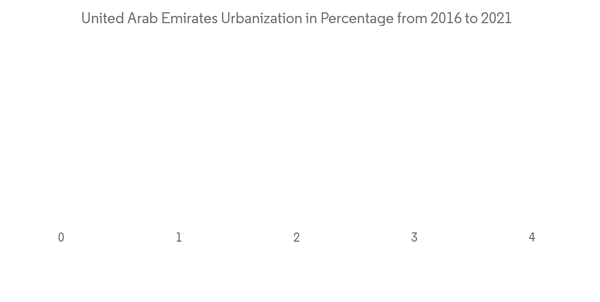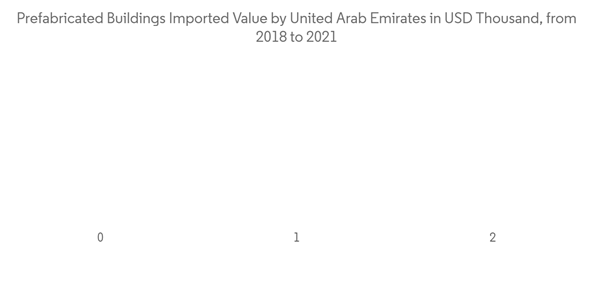Key Highlights
- The COVID-19 pandemic has badly affected the UAE manufactured homes market mainly due to the halt in international trade, prolonged lockdowns, and ceased construction processes. The COVID-19 pandemic has drastically affected the UAE economy. Moreover, it has disrupted the operations of many companies in the manufactured homes market, which has forced the companies to halt their business operations to comply with the safety measures being announced by the governments.
- The market is driven by factors such as the availability of better-quality homes, the requirement for less construction time, the rising demand for energy-efficient homes, and growing construction spending. According to experts, manufactured homes are considered to be 50% more efficient than on-site houses, and hence the growing demand for energy-efficient houses fuels the need for manufactured homes.
- In contrast, low perceived resale value, highly competitive market, and lack of awareness among people are acting as key restraints of this market. Untapped opportunities in emerging countries and rising investment in research and development are expected to create opportunities for the market in the future. Today’s manufactured homes offer amazing interiors and a modern residential outlook from the outside.
UAE Manufactured Homes Market Trends
Rapid Urbanization in UAE Boosts the Demand for Manufactured Homes
Rapid economic growth, which occurred in Dubai after the oil boom of 1973, was accompanied by population growth and increased urbanization. There has been a massive migration of the population from rural to urban areas, as well as immigration of foreign labor into Dubai. In the UAE, 87.3 percent of the population lived in urban areas in 2021, according to World Bank.To accommodate the more and more population shifting towards urban areas, the need for quick and reliable housing is accelerated. People are shifting their focus to manufactured homes rather than traditional construction. Dubai-based LINQ makes modular houses, created as a series of parts that can be shipped and assembled anywhere in the world. This system can build homes 40% faster than regular construction, according to the company, and the ultimate goal is to be able to provide homes to countries that have an increasing demand for housing. Thus, the demand for manufactured homes is strongly driven by rapid urbanization in UAE.
With the increase in the number of people living in urban centers, there is a continued scarcity of homes. Manufactured homes offer an affordable homeownership option for some families, and the improvements in their quality and safety have made them a more desirable option in recent decades. This is expected to drive the growth of the manufactured housing market during the forecast period.
Increasing Demand for Prefabricated Homes in UAE
The economy of the United Arab Emirates is the 5th largest in the Middle East (after Iran, Saudi Arabia, Turkey, and Egypt), with a GDP of USD 501 billion (AED 1.84 trillion) in 2022. Money spent on the construction industry is increasing in UAE; however, developers or manufacturers are looking to decrease the cost and time of construction. This has led to more production of manufactured homes, as they are built in a factory, require less labor, and the overall construction time required is less. These factors are expected to drive the market in the future.According to the Ministry of Energy and Infrastructure (UAE), in 2020, around 92.8 thousand homes were built in the emirate of Abu Dhabi alone, followed by 41 thousand in the emirate of Sharjah and 35 thousand home units in the emirate of Dubai. The total number of homes in the entire United Arab Emirates was projected at 231.2 thousand. According to trade map data, in the year 2021, USD 74464 thousand prefabricated buildings were imported. Massive construction is on the boom, and an expanding manufacturing base and a thriving services sector are helping the UAE diversify its economy. Nationwide, there is currently USD 350 billion worth of active construction projects.
Moreover, people are getting attracted to manufactured housing as they provide features such as a bright modular kitchen, spacious bedroom, a cozy fireplace, walk-in closets, a garden tub, plus crown molding, and branded home appliances. This drives the growth of manufacturing homes in the UAE.
UAE Manufactured Homes Market Competitor Analysis
The UAE manufactured homes market is fairly fragmented with the presence of many international and few local players. Key players in the UAE manufactured homes market include LINQ, Karmod, Bespoke Modular Solutions, Speed House Group of Companies, and Red Sea International Company. The primary strategies being used by the companies include product launches, mergers and acquisitions, and geographical expansion, all of which have the potential to increase a company's ability to extract manufacturing homes. To remain competitive in the market the major players in the market are constantly working to enhance their product offerings to meet the changing needs of the manufactured homes market.Additional Benefits:
- The market estimate (ME) sheet in Excel format
- 3 months of analyst support
Table of Contents
Companies Mentioned (Partial List)
A selection of companies mentioned in this report includes, but is not limited to:
- LINQ
- Karmod
- Bespoke Modular Solutions
- Speed House Group of Companies
- Al Bait Al Raqi
- Red Sea International Company
- Masah Al Murabaa Prefab Houses Ind LLC
- Al Arab Prefab Houses
- Liberty Building System (F.Z.C.)
- Accent
Methodology

LOADING...










